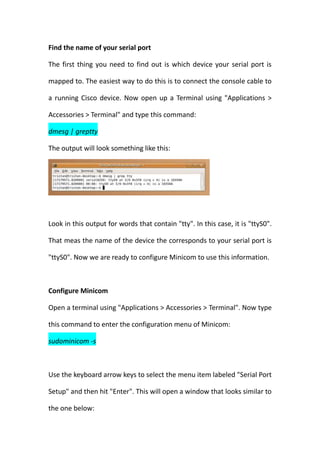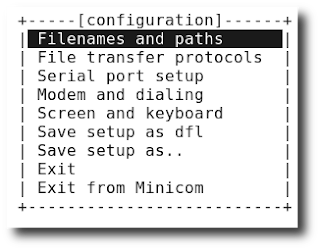

If you can see the hostname "Switch" then that indicates it has connected successfully, enter any command to the switch like show interface for example, and see if you are getting a response to make sure.Lsmod | grep usbserial (If you use a serial cable directly without using a USB to serial device, this step can be skipped) Notice that I am running Minicom calling the "cisco" configuration file that we created earlier, if everything is done correctly press "Enter" right after you run that command and you will be presented with something like this: Welcome to minicom 2.7.1 Communicate with Cisco Switch Serial Consoleīasically, every time you want to communicate with your Cisco switch you will only have to load the configuration file that you have created for Minicom with a simple single command from the terminal. In the main menu choose the Save setup as option and give it a name, in my case I named it as cisco then finally press Enter and you have successfully created a Minicom configuration file to connect with your Cisco switch. Last but not least, I prefer to enable the Hardware Flow Control so just press F on your keyboard and toggle that option to Yes then press Enter to go back to Minicom main menu. Next, press E on your keyboard, resulting in another menu for Bps/Par/Bits rate, from that menu press C to set the rate to 9600 8N1 then press Enter to go back to the serial port setup menu. Now, press A on your keyboard and enter the serial connection path that you have noted from the previous step which is for example something like this /dev/ttyUSB0 in my case, then press Enter to go back to the serial port setup menu. You will be greeted with the main menu list for Mnicom now go to Configuration → Serial Port Setup and you should see another menu to define which serial port path you are going to use. Create Configuration FileĪgain, open the terminal and enter. Note yours down and proceed to the next step. Now, accordingly for each output sample the serial connection path is: What you are looking for is the text marked with white colour as shown in the samples above. usb 3-2: FTDI USB Serial Device converter now attached to ttyUSB0 In the other hand if you are using an USB to RJ45 cable, you should get something like this. Let me show you a sample output if you are using an RS232 to RJ45 cable. The moment you connect the switch from its RJ45 console port to your Linux computer, open up a terminal and enter. Okay, it's time to create a Minicom configuration file.

Configure Minicom to Work with Cisco Switch

I also happen to have one of these and I bought it from this seller on that link. This might be the ideal choice for many of you, because every motherboard will definitely include some USB ports. This won't work if your Linux computer motherboard doesn't have an RS232 DB9 COM Serial Port which leaves you with the second option. I got mine from this seller on that link. This is actually the cable that comes packed originally in the box when you buy the switch, if you don't have one of these just buy from AliExpress or Amazon. In order to connect with the RJ45 console port on the back of your Cisco switch you have two options. Connect RJ45 Console Port to Linux Computer That's about it, you should now be ready to go.
Minicom configuration install#
Debian/Ubuntu sudo -s apt update apt install minicom exit Now, just figure out what is the package manager for your Linux distribution and open up a terminal on your screen. It is used to talk to external RS-232 devices such as mobile phones, routers, and serial console ports. Minicom is a text-based serial port communications program. We need to install the package for "Minicom" which is described by the maintainer as follows: That's why I've been mentioning each distribution matched with its package manager.
Minicom configuration software#
Pacman Package Manager based distributions like Arch and Manjaro.Īnd many others, there's no limit for the diversity of an open source project like Linux but definitely the software and steps we are going to use are the same.RPM Package Manager (RPM) based distributions like CentOS, Fedora, etc.Debian based distributions like Ubuntu, Elementary OS, Mint, etc.Since I am labeling this as a Homelab tutorial where we mostly like to run Linux on our servers and desktop computers, I would rather explain through steps specifically on that operating system and its widely known distributions including: Then, you definitely want to configure it to work in your own network with specific settings because it is a smart switch for which you want to reach its command line through the serial console interface and that's what I am going to explain in details today.


 0 kommentar(er)
0 kommentar(er)
